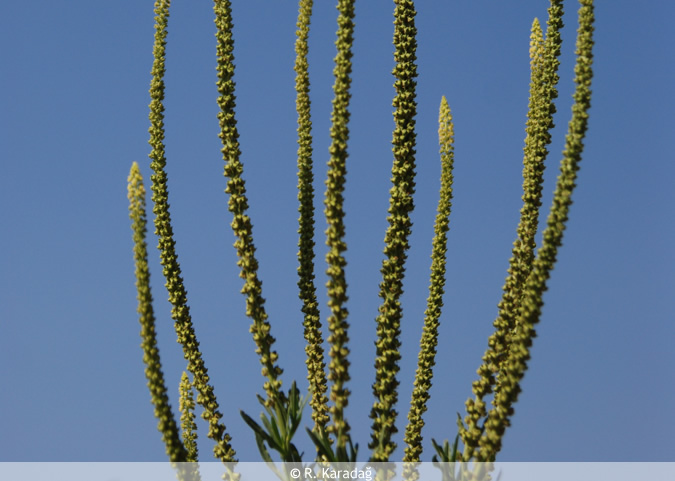This biannual plant produces only a whorl of leaves the first year, but in the second year, it grows to more than five feet. The small, lancet-shaped leaves have no stem. The branching shoots bear numerous insignificant pale yellow flowers in June, in thick, upright clusters. The upper ends follow the sun. All the above-ground parts of the plant, fresh or dried, gathered shortly before it stops blooming in June. Native to Western Asia and the Mediterranean area and now through centuries of cultivation common throughout Europe and the United States . The plant does not require good soil; sand and gravel are adequate if there is enough moisture. Often it is the first plant to take root along new roads and at construction sites where there has been much earthwork.Historical Data
Historical importance in Europe , the weld seems to be used in prehistoric times. The weld seeds were found in lake excavations of cities of Neolithic time, in Switzerland . In the Hellenistic world and in the Roman Empire , it had to be largely cultivated and used. Weld was already known by the Romans as the best dye plant for a lightfast yellow. It was used for dyeing wedding garments and the robes of the vestal virgins. According to Pliny it was used exclusively for women s garments. However weld is one of the oldest yellow producing dyestuffs and still used frequently by dyers. Weld was used by the Egyptian dyers. According to many analyses of Coptic textiles belonging to 3rd to 10th centuries, the principal source of yellow, orange (in combination with the madder) and green (in combination with the indigo) was weld.The olive colour in Nubian textiles (beginning of 6 th century BC) was obtained from weld and iron mordant. According to many receipts the importance of the weld dyeing increased in the Middle Ages. Great quantities of seeds of weld and residues of other dye plants, were found on several urban sites in England , in York (mid 9th - mid 11th century), in Bristol and Beverley (13th 14th century), and in Scotland , in Perth (11th century). According to the merchant Florentin Francesco Balducci Pegolotti, weld was exported from the countries specialized in weld cultivation to various countries: To Italy, Cyprus and Syria . Until the end of the 19th century, weld was cultivated intensively in England , Belgium , Germany and France .At the end of the 18th century, France was the importer of weld , but in the middle of the 19th century, passed to first row as exporter to the world , by the exportation of 112 865 kg of weld in 1856, thanks to the 320 hectares of cultivation. Out of Europe, in the Ottoman Empire the weld was very popular for silk and wool dyeing. It was identified as the source of yellow and green in many silk brocades which were manufactured in the 16th century and in the same period on the Usak carpets, like large kilims with floral motifs in the Divrigi Mosque, in the east of Anatolia and a "Lotto" carpet. Until the mid 20th century weld was one of the two principal sources of yellow and green in Morocco carpets.Cultivation and use of this dye plant in Turkey and Europe disappeared toward the end of the 19th century in the face of competition with the new synthetic dyes. Recently, trial plantings in Europe have been made with the support of the EU, in Brandenburg in Germany , among other places. Since the reintroduction of natural dyes in Turkey in the 1980s, in villages where rugs are made, weld has been growing in many gardens following a one-time sowing or the planting of shoots. It is not necessary to sow every two years, since the plants reproduce by themselves with millions of small black seeds.

